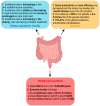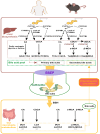Targeting Bile-Acid Metabolism: Nutritional and Microbial Approaches to Alleviate Ulcerative Colitis
- PMID: 40218932
- PMCID: PMC11990178
- DOI: 10.3390/nu17071174
Targeting Bile-Acid Metabolism: Nutritional and Microbial Approaches to Alleviate Ulcerative Colitis
Abstract
Ulcerative colitis (UC) is a chronic inflammatory disease affecting the colorectum, posing a significant global health burden. Recent studies highlight the critical role of gut microbiota and its metabolites, particularly bile acids (BAs), in UC's pathogenesis. The relationship between BAs and gut microbiota is bidirectional: microbiota influence BA composition, while BAs regulate microbiota diversity and activity through receptors like Farnesoid X receptor (FXR) and Takeda G protein-coupled receptor 5 (TGR5). Targeting bile-acid metabolism to reshape gut microbiota presents a promising therapeutic strategy for UC. This review examines the classification and synthesis of BAs, their interactions with gut microbiota, and the potential of nutritional and microbial interventions. By focusing on these therapies, we aim to offer innovative approaches for effective UC management.
Keywords: bile acids; microbiota; nutrition; ulcerative colitis.
Conflict of interest statement
The authors declare no conflicts of interest.
Figures



Similar articles
-
Altered profiles of fecal bile acids correlate with gut microbiota and inflammatory responses in patients with ulcerative colitis.World J Gastroenterol. 2021 Jun 28;27(24):3609-3629. doi: 10.3748/wjg.v27.i24.3609. World J Gastroenterol. 2021. PMID: 34239273 Free PMC article.
-
Dihydromyricetin improves DSS-induced colitis in mice via modulation of fecal-bacteria-related bile acid metabolism.Pharmacol Res. 2021 Sep;171:105767. doi: 10.1016/j.phrs.2021.105767. Epub 2021 Jul 14. Pharmacol Res. 2021. PMID: 34273490
-
Baitouweng Tang ameliorates DSS-induced ulcerative colitis through the regulation of the gut microbiota and bile acids via pathways involving FXR and TGR5.Biomed Pharmacother. 2021 May;137:111320. doi: 10.1016/j.biopha.2021.111320. Epub 2021 Feb 9. Biomed Pharmacother. 2021. PMID: 33578232
-
Cross-talk between bile acids and intestinal microbiota in host metabolism and health.J Zhejiang Univ Sci B. 2015 Jun;16(6):436-46. doi: 10.1631/jzus.B1400327. J Zhejiang Univ Sci B. 2015. PMID: 26055905 Free PMC article. Review.
-
Research Progress on the Mechanism of Bile Acids and Their Receptors in Depression.Int J Mol Sci. 2025 Apr 24;26(9):4023. doi: 10.3390/ijms26094023. Int J Mol Sci. 2025. PMID: 40362260 Free PMC article. Review.
References
-
- Molodecky N.A., Soon I.S., Rabi D.M., Ghali W.A., Ferris M., Chernoff G., Benchimol E.I., Panaccione R., Ghosh S., Barkema H.W., et al. Increasing incidence and prevalence of the inflammatory bowel diseases with time, based on systematic review. Gastroenterology. 2012;142:46–54.e42; quiz e30. doi: 10.1053/j.gastro.2011.10.001. - DOI - PubMed
-
- Jeuring S.F., van den Heuvel T.R., Zeegers M.P., Hameeteman W.H., Romberg-Camps M.J., Oostenbrug L.E., Masclee A.A., Jonkers D.M., Pierik M.J. Epidemiology and Long-term Outcome of Inflammatory Bowel Disease Diagnosed at Elderly Age-An Increasing Distinct Entity? Inflamm. Bowel Dis. 2016;22:1425–1434. doi: 10.1097/MIB.0000000000000738. - DOI - PubMed
Publication types
MeSH terms
Substances
Grants and funding
LinkOut - more resources
Full Text Sources
Medical

